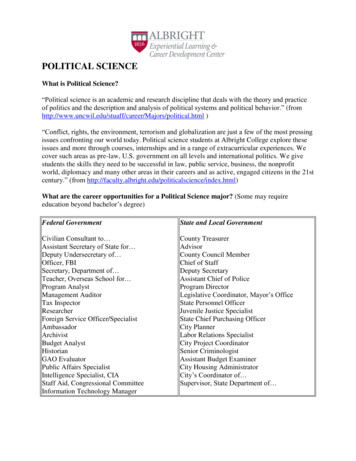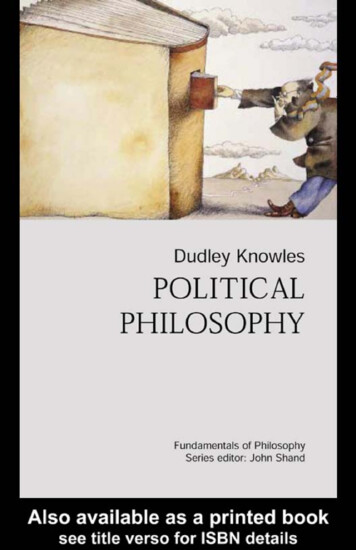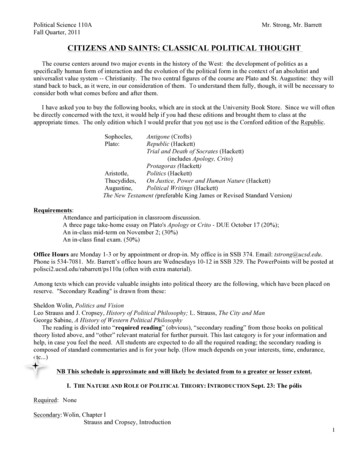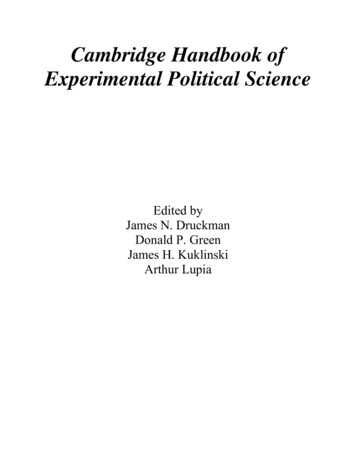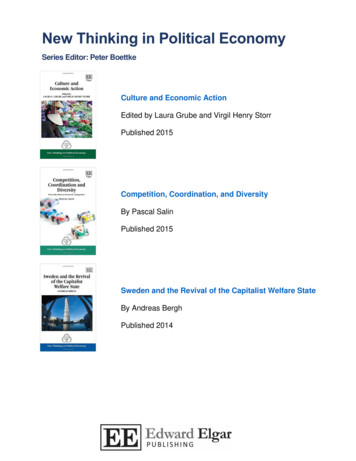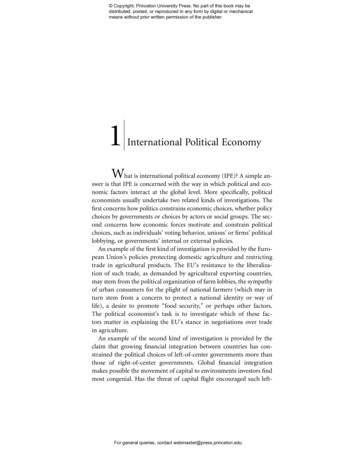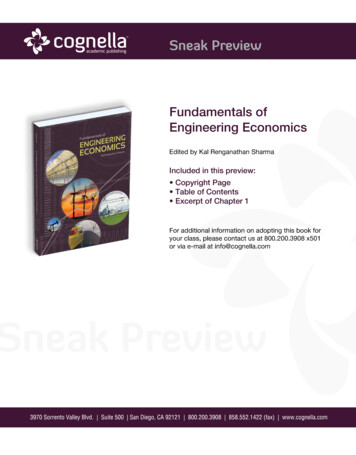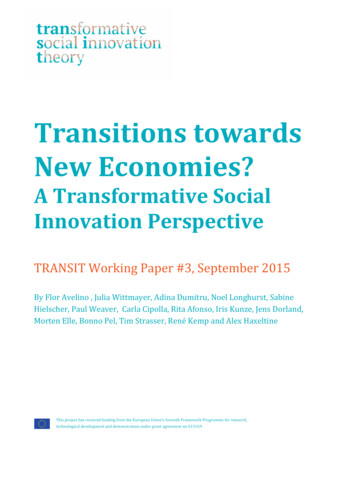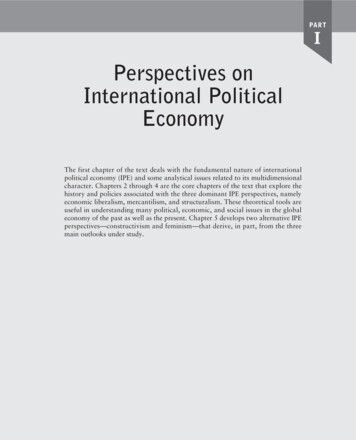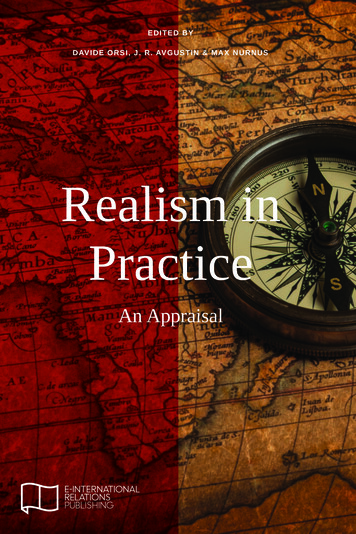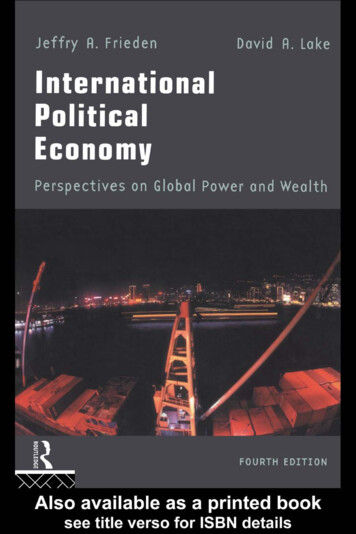
Transcription
INTERNATIONALPOLITICALECONOMYPERSPECTIVES ONGLOBAL POWERAND WEALTHFOURTH EDITIONJeffry A.FriedenHarvard UniversityDavid A.LakeUniversity of California, San DiegoLondon and New York
For Bedford/St. Martin’sPolitical Science Editor: James R.HeadleySenior Editor, Publishing Services: Douglas BellProduction Supervisor: Joe FordProject Management: Stratford Publishing Services, Inc.Cover Design: Lucy KrikorianCover Photo: CORBIS/Stuart WestmorlandComposition: Stratford Publishing Services, Inc.Printing and Binding: Haddon Craftsman, an R.R.Donnelley & Sons CompanyPresident: Charles H.ChristensenEditorial Director: Joan E.FeinbergDirector of Editing, Design, and Production: Marcia CohenManager, Publishing Services: Emily BerlethFirst published 2000 by Bedford/St. Martin’s. Simultaneously published and distributedoutside North America byRoutledge11 New Fetter Lane, London, EC4P 4EEand representatives throughout the world.This edition published in the Taylor & Francis e-Library, 2003.Library of Congress Catalog Card Number: 99–62343Copyright 2000 by Bedford/St. Martin’sAll rights reserved. No part of this book may be reproduced, stored in a retrieval system, ortransmitted in any form or by any means, electronic, mechanical, photocopying, recording,or otherwise, except as may be expressly permitted by the applicable copyright statutes orin writing by the Publisher.British Library Cataloguing in Publication DataA catalogue record for this book is available from the British Library.ISBN 0-203-51858-6 Master e-book ISBNISBN 0-203-54705-5 (Adobe eReader Format)ISBN: 0-415-22279-6 (Print Edition)AcknowledgmentsAcknowledgments and copyrights appear at the back of the book on pages 471–473, whichconstitute an extension of the copyright page.It is a violation of the law to reproduce the selections in this book by any means whatsoeverwithout the written permission of the copyright holder.
PREFACEThe readings in International Political Economy: Perspectives on Global Powerand Wealth are primarily intended to introduce the study of international politicaleconomy to those with little or no prior knowledge of it. The book is designed foruse in courses in international political economy, international relations, andinternational economics. The selections present both clear and identifiable theoreticalarguments and important substantive material. Fifteen of the 31 articles are newto this fourth edition of our book, and the theoretical approach has been updatedto reflect the changing state of both the world and the field of international politicaleconomy.Although the selections can be read in any order, they are grouped in sevenparts, which reflect some of the more common organizing principles used ininternational political economy courses. Each part begins with an introduction bythe editors that provides background information and highlights issues raised inthe readings. Each reading is preceded by an abstract summarizing its specificarguments and contributions. The readings were edited to eliminate extraneous ordated information, and most footnotes were removed.The introduction defines the study of international political economy,summarizes major analytical frameworks in the field, and identifies several currentdebates. In earlier editions, the introduction and readings were largely structuredaround three analytic perspectives: Realism, Marxism, and Liberalism. Thisframework is substantially downplayed in this edition. The field of internationalpolitical economy has made significant progress over the last two decades, andthis division—while useful as a pedagogic device—has become increasinglyobsolete. To capture the most important work and current debates in theinternational political economy, we now highlight the analytic tensions betweeninternational and domestic explanations, on the one hand, and institutionalistand society-centered explanations, on the other. These two dimensions createfour distinct views, which we refer to as the international political, internationaleconomic, domestic institutionalist, and domestic societal approaches. Part Ipresents examples of these different perspectives on international politicaleconomy. The readings in this part are intended to suggest the underlying logicand types of arguments used by proponents of each approach. Although theyare representative of their respective schools, they do not necessarily capturethe wide range of opinion within each approach.iii
ivPrefacePart II, which reviews the history of the international economy since thenineteenth century, provides the background and perspective necessary to understandthe contemporary international political economy. The selections describe the majordevelopments in the history of the modern international economy from a varietyof different theoretical viewpoints.The remainder of the book is devoted to the modern international politicaleconomy. Separate sections on production, money and finance, and trade look atthe principal broad issue areas associated with the politics of international economicrelations. Part VI focuses on the particular political and economic problems ofdeveloping and transitional economies. Finally, Part VII examines current problemsin the politics of international economics.The selections in this volume have been used successfully in our courses oninternational political economy at the University of California, Los Angeles; HarvardUniversity; and the University of California, San Diego (UCSD). In our ownresearch, we approach the study of international political economy from verydifferent perspectives. Yet we find that this set of readings accommodates ourindividual approaches to the subject matter while simultaneously covering themajor questions of the field.For this edition, Patricia Lindenboim and Michael Spence at Harvard and AngelaO’Mahony at UCSD provided valuable research and editorial assistance. LeslieS.Connor of Stratford Publishing Services prepared the manuscript for publication.We want to thank our respective spouses, Anabela Costa and Wendy K.Lake, fortheir continuing encouragement.Jeffry A.FriedenDavid A.Lake
CONTENTSPreface iiiAbout the EditorsixIntroduction: International Politics and International EconomicsI1CONTENDING PERSPECTIVES ON INTERNATIONALPOLITICAL ECONOMY 171 State Power and the Structure of International Trade 19STEPHEN D.KRASNER2 The Political Economy of the Smoot-Hawley Tariff 37BARRY EICHENGREEN3 Institutions and Economic Growth: A Historical Introduction 47DOUGLASS C.NORTH4 States, Firms, and Diplomacy 60SUSAN STRANGEIIHISTORICAL PERSPECTIVES695 The Rise of Free Trade in Western Europe 73CHARLES P.KINDLEBERGER6 International Trade, Domestic Coalitions, and Liberty:Comparative Responses to the Crisis of 1873–189690PETER ALEXIS GOUREVITCHv
viPreface7 International Investment and Colonial Control:A New Interpretation109JEFFRY A.FRIEDEN8 British and American Hegemony Compared:Lessons for the Current Era of Decline127DAVID A.LAKEIIIPRODUCTION1419 The Multinational Enterprise as an Economic Organization 145RICHARD E.CAVES10 Third World Governments and Multinational Corporations:Dynamics of Host’s Bargaining Power156SHAH M.TARZI11 “A New Imperial System”? The Role of theMultinational Corporations Reconsidered167DAVID FIELDHOUSE12 Strategic Trade and Investment Policies: Implicationsfor the Study of International Political EconomyJEFFREY A.HARTIVAND180ASEEM PRAKASHMONEY AND FINANCE19313 The Domestic Politics of International Monetary Order:The Gold Standard199LAWRENCE BROZ14 Hegemonic Stability Theories of theInternational Monetary System220BARRY EICHENGREEN15 The Triad and the Unholy Trinity:Problems of International Monetary CooperationBENJAMIN J.COHEN16 Exchange Rate Politics 257JEFFRY A.FRIEDEN17 EMU: Why and How It Might Happen 270CHARLES WYPLOSZ245
Prefacevii18 The Obsolescence of Capital Controls?Economic Management in an Age of Global MarketsJOHN B.GOODMANVTRADEAND280LOUIS W.PAULY29919 Protectionist Trade Policies: A Survey of Theory,Evidence, and Rationale303CLETUS C.COUGHLIN, K.ALEC CHRYSTAL,ANDGEOFFREY E.WOOD20 Commerce and Coalitions: How Trade AffectsDomestic Political Alignments318RONALD ROGOWSKI21 The Political Economy of Trading States:Factor Specificity, Collective Action Problems,and Domestic Political Institutions 327JAMES E.ALTANDMICHAEL GILLIGAN22 Are Your Wages Set in Beijing? 343RICHARD B.FREEMAN23 The Political Economy of Nontariff Barriers:A Cross-national AnalysisEDWARD D.MANSFIELDAND353MARC L.BUSCH24 Explaining Business Support for Regional Trade Agreements 366RONALD W.COXVIECONOMIES IN DEVELOPMENT AND TRANSITION37725 International Development: Is It Possible? 383JOSEPH E.STIGLITZANDLYN SQUIRE26 Development: The Market Is Not Enough 392ROBIN BROAD, JOHN CAVANAGH,ANDWALDEN BELLO27 Globalization and Inequality, Past and Present 405JEFFREY A.WILLIAMSON28 Inflation and Stabilization 417STEPHAN HAGGARD
viiiVIIPrefaceCURRENT PROBLEMS IN INTERNATIONALPOLITICAL ECONOMY 43129 Environmental Protection and Free Trade:Are They Mutually Exclusive?433ALISON BUTLER30 Globalization and the Changing Logic of Collective Action 446PHILIP G.CERNY31 Sense and Nonsense in the Globalization Debate 461DANI RODRIKINDEX471
ABOUT THE EDITORSJeffry A.Frieden (Ph.D., Columbia University) is professor of government atHarvard University. He specializes in the political economy of international monetaryand financial relations. His book publications include Debt, Development, andDemocracy: Modern Political Economy and Latin America, 1965–1985 (Princeton:Princeton University Press, 1991) and Banking on the World: The Politics ofAmerican International Finance (New York: Harper & Row, 1987), which hasbeen issued in both Japanese and British editions.David A.Lake (Ph.D., Cornell University) is professor of political science atthe University of California, San Diego, and coeditor of the journal InternationalOrganization. He has published widely in the field of international relationsand international political economy. His principal book publications includePower, Protection, and Free Trade: International Sources of U.S. CommercialStrategy, 1887–1939 (Ithaca: Cornell University Press, 1988) and EntanglingRelations: American Foreign Policy in its Century (Princeton: PrincetonUniversity Press, 1999).ix
IntroductionINTERNATIONALPOLITICS ANDINTERNATIONALECONOMICSOver the past thirty years, the study of international political economy underwenta remarkable resurgence. Virtually nonexistent before 1970 as a field of study,international political economy is now a popular area of specialization for bothundergraduates and graduate students, as well as the source of much innovativeand influential scholarship. The revival of international political economy afternearly forty years of dormancy enriched both social science and public debate,and promises to continue to do both.International political economy is the study of the interplay of economicsand politics in the world arena. In the most general sense, the economy can bedefined as the system of producing, distributing, and using wealth; politics isthe set of institutions and rules by which social and economic interactions aregoverned. Political economy has a variety of meanings. For some, it refersprimarily to the study of the political basis of economic actions, the ways inwhich government policies affect market operations. For others, the principalpreoccupation is the economic basis of political action, the ways in whicheconomic forces mold government policies. The two focuses are, in a sense,complementary, for politics and markets are in a constant state of mutualinteraction.Most markets are governed by certain fundamental laws that operate moreor less independently of the will of firms and individuals. Any shopkeeperknows that an attempt to raise the price of a readily available and standardizedproduct—a pencil, for example—above that charged by nearby and competingshopkeepers will rapidly cause customers to stop buying pencils at the higherprice. Unless the shopkeeper wants to be left with piles of unsold pencils, heor she will have to bring the price back into line with “what the market willbear.” The shopkeeper will have learned a microcosmic lesson in whateconomists call market-clearing equilibrium, the price at which the numberof goods supplied equals the number demanded—the point at which supplyand demand curves intersect.At the base of all modern economics is the general assertion that, within certain1
2Introductioncarefully specified parameters, markets operate in and of themselves to maintainbalance between supply and demand. Other things being equal, if the supply of agood increases far beyond the demand for it, the good’s price will be driven downuntil demand rises to meet supply, supply falls to meet demand, and market-clearingequilibrium is restored. By the same token, if demand exceeds supply, the good’sprice will rise, thus causing demand to decline and supply to increase until thetwo are in balance.If the international and domestic economies functioned as perfectly competitivemarkets, they would be relatively easy to describe and comprehend. But suchmarkets are only highly stylized or abstract models, which are rarely reproducedin the real world. A variety of factors influence the workings of domestic andinternational markets in ways that a focus on perfectly competitive and unchangingmarket forces does not fully capture. Consumer tastes can change—how largeis the American market for spats or sarsaparilla today?—as can the technologyneeded to make products more cheaply, or even to make entirely new goodsthat displace others (stick shifts for horsewhips, calculators for slide rules).Producers, sellers, or buyers of goods can band together to try to raise or lowerprices unilaterally, as the Organization of Petroleum Exporting Countries (OPEC)did with petroleum in 1974 and 1979. And governments can act, consciously orinadvertently, to alter patterns of consumption, supply, demand, prices, andvirtually all other economic variables.This last fact—the impact of policy and politics on economic trends—is themost visible, and probably the most important, reason to look beyond marketbased, purely economic explanations of social behavior. Indeed, many marketoriented economists are continually surprised by the ability of governments or ofpowerful groups pressuring governments to contravene economic tendencies. WhenOPEC first raised oil prices in December 1973, some market-minded pundits, andeven a few naive economists, predicted that such naked manipulation of the forcesof supply and demand could last only a matter of months. However, what hasemerged from the past thirty years’ experience with oil prices is the recognitionthat they are a function of both market forces and the ability of OPEC’s memberstates to organize concerted intervention in the oil market.Somewhat less dramatic are the everyday operations of local and nationalgovernments, which affect prices, production, profits, wages, and almost everyother aspect of the economy. Wage, price, and rent controls; taxation; incentivesand subsidies; tariffs and other barriers to trade; and government spending allserve to mold modern economies and the functioning of markets themselves. Whocould understand the suburbanization of the United States after World War IIwithout taking into account government tax incentives to home mortgage-holders,government-financed highway construction, and politically driven patterns of localeducational expenditures? How many American (or Japanese or European) farmerswould be left if agricultural subsidies were eliminated? How many Americanswould have college educations were it not for public universities, governmentscholarships and publicly subsidized student loans, and tax exemptions for privateuniversities? Who could explain the proliferation of nonprofit groups in the UnitedStates without knowing the tax incentives given to charitable donations?
Introduction3In these instances and many more, political pressure groups, politicians, andgovernment bureaucrats have at least as much effect on economic outcomes as dothe laws of the marketplace. Social scientists, especially political scientists, havespent decades trying to understand how these political pressures interact to producegovernment policy. Many of the results provide as elegant and stylized a view ofpolitics as the economics profession has developed of markets. As in economics,however, social science models of political behavior are little more than didacticdevices whose accuracy depends on a wide variety of unpredictable factors, includingunderlying economic trends. If an economist would be equally foolish to dismissthe possibilities of intergovernmental producers’ cartels (such as OPEC) out ofhand, a political scientist would be foolish not to realize that the economic realitiesof modern international commodity markets ensure that successful producers’ cartelswill be few and far between.It is thus no surprise that political economy is far from new. Indeed, until acentury ago, virtually all thinkers concerned with understanding human societywrote about political economy. For individuals as diverse as Adam Smith, JohnStuart Mill, and Karl Marx, the economy was eminently political and politics wasobviously tied to economic phenomena. Few scholars before 1900 would havetaken seriously any attempt to describe and analyze politics and economicsindependently of each other.Around the turn of the century, however, professional studies of economicsand politics became increasingly divorced from one another. Economic investigationbegan to focus on understanding more fully the operation of specific markets andtheir interaction; the development of new mathematical techniques permitted theformalization of, for example, laws of supply and demand. By the time of WorldWar I, an economics profession per se was in existence, and its attention wasfocused on understanding the operation of economic activities in and of themselves.At the same time, other scholars were looking increasingly at the political realmin isolation from the economy. The rise of modern representative politicalinstitutions, mass political parties, more politically informed populations, and modernbureaucracies all seemed to justify the study of politics as an activity that had alogic of its own.With the exception of a few isolated individuals and an upsurge of interestduring the politically and economically troubled Depression years, the twentiethcentury saw an increasing separation of the study of economics from that of politics.Economists developed ever more elaborate and sophisticated models of howeconomies work, and similarly, political scientists spun out ever more complextheories of political development and activity.The resurgence of political economy after 1970 had two, interrelated sources.The first was dissatisfaction among academics with the gap between abstract modelsof political and economic behavior, on the one hand, and the actual behavior ofpolities and economies, on the other. Theory had become more ethereal and seemedless realistic. Many scholars therefore questioned the intellectual justificationsfor a strict analytic division between politics and economics. Second, as the stabilityand prosperity of the first twenty-five postwar years started to disintegrate in theearly 1970s, economic issues became politicized while political systems became
4Introductionincreasingly preoccupied with economic affairs. In August 1971, President RichardNixon ended the gold-dollar standard, which had formed the basis for postwarmonetary relations; two and a half years later, OPEC, a previously little-knowngroup, succeeded in substantially raising the price of oil. In 1974 and 1975, theindustrial nations of Western Europe, North America, and Japan fell into the firstworldwide economic recession since the 1930s; unemployment and inflation weresoon widespread realities and explosive political issues. In the world arena, theunderdeveloped countries—most of them recently independent—burst onto centerstage as the Third World and demanded a fairer division of global wealth andpower. If in the 1950s and 1960s, economic growth was taken for granted andpolitics occupied itself with other matters, in the 1970s and 1980s, economicstagnation fed political strife while political conflict exacerbated economicuncertainty.For both intellectual and practical reasons, then, social scientists began seeking,once more, to understand how politics and economics interact in modern society.As interest in political economy grew, a series of fundamental questions was posedand a broad variety of contending approaches arose.To be sure, today’s political economists have not simply reproduced the studies ofearlier (and perhaps neglected) generations of scholars in the discipline. Theprofessionalization of both economics and political science led to major advances inboth fields, and scholars now understand both economic and political phenomena farbetter than they did a generation ago. It is on this improved basis that the new politicaleconomy has been constructed, albeit with some long-standing issues in mind.Just as in the real world, where politicians pay close attention to economic trendsand economic actors keep track of political tendencies, those who would understandthe political process must take the economy into account, and vice versa. A muchricher picture of social processes emerges from an integrated understanding of bothpolitical and economic affairs than from the isolated study of politics and economicsas separate realms. This much is, by now, hardly controversial; it is in applicationthat disagreements arise. Government actions may influence economic trends, butthese actions themselves may simply reflect the pressures of economic interest groups.Economic interest groups may be central in determining government policy, yet thepolitical system—democratic or totalitarian, two-party or multiparty, parliamentaryor presidential—may crucially color the outlooks and influence of economic interests.In the attempt to arrive at an integrated view of how politics and economics interact,we must disentangle economic and political causes from effects. In this effort, differentscholars have different approaches, with different implications for the resulting viewsof the world.CONTENDING PERSPECTIVES ONINTERNATIONAL POLITICAL ECONOMYAnalysts of the international political economy must understand the interactionof many disparate forces. It is possible to simplify many such factors so that theycan be arrayed on two dimensions. These two dimensions also capture many of
Introduction5the theoretical disagreements that characterize scholarship on the politics ofinternational economic relations. One set of disagreements has to do with therelationship between the international and domestic political economies; anotherset concerns the relationship between the state and social forces.The first dimension of interest concerns the degree to which the causes ofinternational political and economic trends are to be found at the domestic orinternational level. All observers agree that in a complex world, both global andnational forces are important. But different analysts place different emphases onthe importance of one or the other. Some focus on how international forces tendto overpower domestic interests; others emphasize the degree to which nationalconcerns override global considerations.It should surprise no one that, for example, American trade policy, Japan’sfinancial goals, and South Korean development strategies are important in theworld’s political economy. Disagreements arise, however, over how best to explainthe sources of the foreign economic policies of individual nations, or of nationstates in general. At one end of the spectrum, some scholars believe that nations’foreign economic policies are essentially determined by the global environment.The actual room for national maneuver of even the most powerful of states, thesescholars believe, is limited by characteristics inherent in the international system.At the other end of the spectrum are scholars who see foreign economic policiesprimarily as the outgrowth of nations’ domestic-level political and economicprocesses. For them, the international system exists only as a jumble of independentnation-states, each with its own political and economic peculiarities.The international-domestic division is at the base of many debates within internationalpolitical economy, as in the world at large. While some argue, for example, that thecause of Third World poverty is in the unequal global economic order, others blamedomestic politics and economics in developing nations. Similarly, many scholars seemultinational corporations as a powerful independent force in the world—whetherworking for good or for evil—while others see international firms as extensions oftheir home countries. Moreover, for some analysts, global geopolitical relations amongnations dominate the impulses that arise from their domestic social orders.The distinction between the two approaches can be seen quite clearly, forexample, in explanations of trade policy. To take a specific instance, starting inthe early 1980s the United States and many European governments imposedrestrictions on the import of Japanese automobiles. The form of the controls variedwidely: the U.S. and Japanese governments negotiated “voluntary” export restraints,with which Japanese producers agreed to comply, while in some European countries,quantitative quotas were imposed unilaterally. Concerned about stiff Japanesecompetition, which was reducing profits and employment, European and NorthAmerican automakers and the trade unions that represent their employees providedkey support for these policies.From this example, one clear analytic conclusion would be that domestic politicaland economic pressures—the electoral importance of the regions where autoindustries are concentrated; the economic centrality of that sector to the Europeanand North American economies; government concern about the broad, nationalramifications of the auto industry; the political clout of the autoworkers’ unions—
6Introductionled to important foreign economic measures involving the restriction of Japaneseautomobile imports. Indeed, many scholars saw the restrictions as confirmationof the primacy of domestic concerns in the making of foreign economic policy.Yet analysts who search for the causes of national foreign economic policiesin the international rather than the domestic arena could also find support in theauto import restrictions. After all, the policies were responsive to the rise of Japanas a major manufacturer and exporter of automobiles, a fact that had little to dowith the domestic scene in the United States or Europe. Many North Americanand European industries had lost competitive ground to rapidly growing overseasmanufacturers, a process that is complex in origin but clearly one of worldwideproportions. Some have argued that trade policies are a function of realities inherentin the international system, such as the existence of a leading, hegemonic powerand the eventual decline of that state (see Krasner, Reading 1). In this view, thedecline of American power set the stage for a proliferation of barriers to trade.The internationally minded scholar might also argue that it is important tounderstand why the European and American measures took the relatively mild formthey did in simply limiting the Japanese to established (and, often, very appreciable)shares of the markets. If the measures had been adopted solely to respond to thedistress of local auto industries, the logical step would have been to exclude foreigncars from the markets in question. Yet the positions of Europe and the United Statesin the global economic and political system—including everything from world financeto international military alliances—dictated that European and North Americanpolicymakers not pursue overly hostile policies toward the Japanese.More generally, scholars have explained long-term changes in trade policy invery different ways. During the period between World Wars I and II, and especiallyin the 1930s, almost all European nations and the United States were highlyprotectionist. After World War II, on the other hand, the North American and WesternEuropean markets were opened gradually to one another and to the rest of the world.Scholars whose theoretical bent is international point out that domestic politicsin Europe and the United States did not change enough to explain such a radicalshift. But the postwar role of the United States and Western Europe in theinternational political and economic system has indeed been different from whatit was during the 1930s: after 1945, North American and Western European countrieswere united in an American-led military and economic alliance against the SovietUnion. Some internationally oriented analysts argue that the causes of postwarforeign economic policies in North America and Western Europe can be found ininternational geopolitical positions of these regions—the increase in Americanpower, the decline of Europe, the Soviet challenge, and the rise of the AtlanticAlliance. Others point to broad technological and economic developments, suchas dramatic improvements in telecommunications and transportation, that havealtered governments’ incentives to either protect or open their economies.Scholars who promote domestic-level explanations take the opposite tack. Forthem, the postwar system was itself largely a creation of the United States and themajor Western European powers. To cite the modern international political economyas a source of American or British foreign economic policy, these scholars argue,is to put the cart before the horse in that the United States an
use in courses in international political economy, international relations, and international economics. The selections present both clear and identifiable theoretical arguments and important substantive material. Fifteen of the 31 articles are new to this fourth edition of our boo
